Life is impossible without flowers and flowering plants. Nine-tenths of that part of the world that is covered with vegetation is covered with flowering plants. In this chapter, we are going to study about the structure of a flowering plant and the modifications which the various plant organs have undergone to ensure their survival.
1. CELLS TO ORGANISMS
We know, basic structural unit of living organisms, the cell, was described. Let us see how the cells are organized to form the multicellular body of living organisms.
Cells in multicellular organisms are not similar. Rather they are specialized to perform different functions. For example, nerve cells are specialized to conduct messages while muscle cells are specialized to conduct and help in locomotion.
The specialized cells, which group together to perform a particular function are known as tissues. A tissue represents a group of cells similar in structure and function.
Different tissues are often grouped together into larger units called organs. An organ, thus, consists of several different tissues. For example, stomach is an organ to digest food, and is made up of different tissues like epithelial and muscular tissues. Similarly, heart is an organ consisting of muscular and nervous tissues. Likewise in plants, the root, stem, leaves and flowers are the different organs which perform different functions and consist of various tissues.
Organs, in turn, are organized into organ-systems. An organ-system consists of different organs that function together. For example, the digestive system consists of various organs like the mouth, stomach, intestine, liver, pancreas and rectum which perform the role of digestion of the ingested food.
Different organ-systems comprise the multicellular organism. This organization of cells into tissues, organs, organ-systems and the organism is found in all multicellular organisms – plants as well as animals.
2. PARTS OF A FLOWERING PLANT
We have studied earlier that a flowering plant may be a herb, shrub or a tree. Now collect a herb along with its underground parts.
Having collected a herb, see into what parts can you divide this plant.
A flowering plant can be divided into two parts
(Figure) :
(i) An underground part called the root system, and
(ii) An above ground part called the shoot system.
The root system consists of the roots, while the shoot system consists of the stem, branches, leaves, flowers and fruits.
The root, stem and leaves constitute the vegetative parts of a plant body. The shoot system also bears the flowers and fruits which comprise the reproductive parts.
Parts of flowering plant
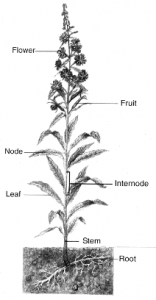
3. THE ROOT SYSTEM
The part of the plant body which fixes it to the soil is called the root system. In certain plants like mustard, gram, pea, balsam, tulsi, marigold, rose, oleander, mango and neem, the root system consists of a main root called the tap root (Figure) and its branches.The tap root grows vertically down into the soil and then gives out branches.
In some plants like wheat, maize, millets, other grasses, sugarcane and banana, there is no main root. A number of roots arise in a cluster below the stem and spread out in the soil. Such roots are called Fibrous root fibrous roots (Figure).
Tap root

Fibrous root

Functions
1. Roots fix the plant to the soil.
2. Roots absorb water and mineral salts from the soil which are then conducted upwards to the stem and leaves.
3. Roots help in holding the soil together, thus, preventing erosion or blowing away of the soil particles.
4. In some plants, roots are modified to perform additional functions of storage, support or respiration.
Modifications of Root for Storage
In plants like sweet potato, radish, carrot, turnip and beet root, the roots instead of spreading in the soil, become swollen [Figure.(a), (b), (c)]. These swollen roots store food, which we eat. Such roots are called tuberous roots.
Figure(a) Modified root of Turnip

(b) Modified root of Sweet potato

(c) Modified root of Carrot
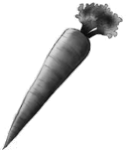
Modifications of Root For Additional Support
In the Botanical Garden at Kolkata, a 200 year old banyan (bargad) tree which has a crown circumference of more than 400 metres is present. In banyan, a number of roots arise from the tree branches and these roots grow downwards. These roots are called supporting roots or prop roots. These act as pillars and support the big heavy horizontal branches (figure). Maize and sugarcane also have supporting roots.
Supporting roots of Banyan tree

Breathing roots in mangrove plant

Modification of Root For Respiration
In certain plants growing in saline marshy habitats, the root system produces vertically upward growing branches above the soil. These roots help in respiration and are known as breathing roots or pneumatophores, as found in mangrove plants like Rhizophora (Figure).
4. THE STEM
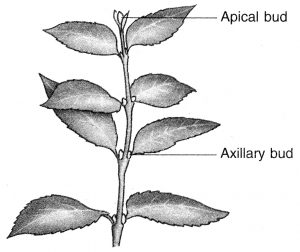
Buds
Stem forms the main axis of the plant body. It is divided into nodes and internodes. The place from where the branches and leaves arise on the stem is called the node. The portion of the stem between two nodes is called the internode.
The tip of the stem or a branch bears an apical or terminal bud(Figure).Apical bud helps in lengthwise growth of the plant, that is, it leads to an increase in the height of the plant body. Buds are present in the axils of leaves too. These buds are called axillary buds. They grow into branches.
When young, a stem is green and soft. In an herb, the stem remains soft and tender. But in a tree, it becomes hard and woody and is called the trunk.
It is no longer green. It becomes brownish in colour, and is in fact covered with bark. The bark protects the inner parts of the tree.
In some plants, the stem is very weak and needs a support to stand erect and grow. Such plants are called climbers. Grapevine, sweet pea and cucurbita are some examples of climbing plants.
Functions
1. A stem bears the leaves, flowers and fruits. It serves as a link between the roots, the leaves and flowers.
2. The stem and its branches hold the leaves in such a manner that the leaves get maximum possible sunlight.
3. When young, it is green and manufactures food through the process of photosynthesis.
4. It carries water and mineral salts from the roots to the leaves and flowers.
5. It carries food manufactured in the leaves to roots and other parts of the plant body.
6. In some cases, the stems may be modified to perform the functions of storage, food-manufacture (photosynthesis), and support.
Modifications of Stem For Storage
(a) In some plants, the stems are underground. The underground stems are modified to store food materials, and help the plant to survive unfavourable conditions. The underground modifications are stems, as they possess nodes and internodes.
The main modifications are as follows:
(i) Tuber : Look at a potato. It is a small, thick and fleshystructure. It has buds which are called ‘eyes’. It also hassome scaly leaf-like structure (Figure. a).
This swollen-structure which stores food (in the form of starch) is calleda tuber. New plants develop from the ‘eyes’ of the tuber.
(ii) Bulb : Observe an onion (Figure. b). It is a thick, bulb-like structure. The stem is short and bears small fibrousroots at the base and leaves above.
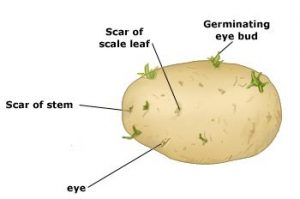
(a): Tuber of potato
The outer leaves are dry and scaly (scale leaves). The outer dry scales enclose thick fleshy leaves which store food.
(iii) Rhizome : In plants like ginger and turmeric, food is stored in underground stems called rhizomes (Figure. c). In a piece of ginger (adrak), we will find nodes and internodes, brown scale leaves arising from nodes, small buds and adventitious roots.
(b): Bulb of onion
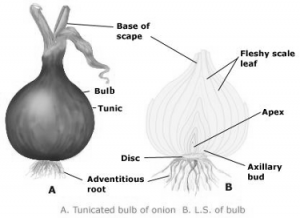
(c): Rhizome of ginger
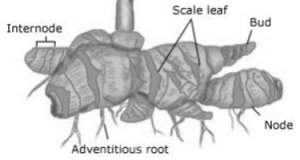
(b) In cactus plant (Figure.), the stem becomes fleshy and green. The stem prepares food and also stores water for long periods. The leaf is reduced to spines. Prickly poppy (Opuntia) is another such type of plant.
A cactus plant; the stem prepares food
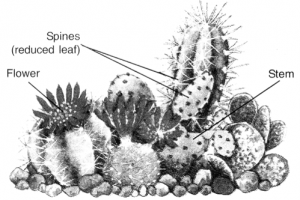
Modification of Stem For Photosynthesis
Look at the cactus plant again. In addition to the stem being fleshy, it is green, too. The green stem performs the functions of the leaf. It manufactures food for the plant. Leaves are reduced to spines.
Modification of Stem For Support
In climbers like grape vine, cucurbita, gourd or passion flower, the stem is very weak and needs support (Fig).
The thread-like structures are called the stem tendrils as these are modifications of stem. The tendrils coil around any object in the neighbourhood and thereby help the plant to climb up.
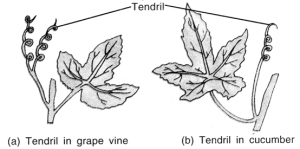
Tendrils
|
DIFFERENCES BETWEEN ROOT AND STEM |
|
| Root | Stem |
| 1. Develops from radicle.
2. Nodes and internodes absent. 3. Never green. 4. Leaves and buds absent. 5. Generally develops below ground. |
1. Develops from plumule.
2. Nodes and internodes present. 3. Often green. 4. Bears leaves and buds. 5. Generally develops above ground. |
5. THE LEAF
A leaf is a flattened green structure. It arises from the node of a stem or its branches. Leaves differ in shape and size.
The flat green part of a leaf is known as the leaf blade or lamina. It is attached to the stem by means of a short stalk called the petiole
(Figure.). The region of attachment of the leaf with the stem is called the leaf base.
Structure showing parts of a leaf
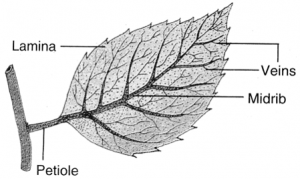
The leaf blade has many fine veins forming a network throughout its body. The arrangement of veins in the leaf blades is called venation.
Leaves contain a pigment called chlorophyll. This pigment imparts green colour to the leaves.
Functions
(1) Leaves manufacture food for the plant body. The process of manufacturing food by the leaves is called photosynthesis. Leaves require water, carbon dioxide, sunlight and chlorophyll for making food.
(2) The leaves on their surfaces carry tiny pores called stomata. Through these pores, plants take in gases for respiration and photosynthesis. The gases produced during these processes are also given out through stomata.
(3) The plants give out extra amount of water in the plant through stomata, in the form of vapours. This process is known as transpiration.
(4) In addition, leaves may be variably modified into spines or tendrils or modified to trap insects.
| · The largest leaf is present in Giant, Water lilly, Victoria regia, more than 1metre in diameter. · Flowering plant with no leaf-Dodder (Cuscuta). · All leaves are not green. Some leaves have patches of white or yellow or red colour. Such leaves are called variegated leaves. · Plants with variegated leaves – Money plant (Coleus). |
Types of Leaves
(i) Simple and Compound leaves:
Try to examine the leaves of mango and neem trees. In a mango leaf, the lamina is entire whereas in a neem plant, the leaf lamina is cut into small parts, called leaflets, on a common stalk.
The leaf with a single lamina, as in mango, castor, cotton, china-rose, is called a simple leaf
(Figure). A simple leaf has an axillary bud. The leaf in which the lamina is cut into a number of small leaflets on a common stalk is called a compound leaf(Figure). Rose, neem, tamarind show compound leaves. Leaflets do not bear axillary buds. The stalk of a compound leaf is called rachis which has an axillary bud.
A simple leaf

A compound leaf

Venation
Venation found in the leaves is of two types.
(i) Reticulate and (ii) Parallel.
Reticulate venation: When the veins in the leaf lamina divide repeatedly forming a network, it is called reticulate venation (Figure).
Examples: Dicotyledonous plants like mango, peepal show this type of venation.
Parallel venation: When the veins run parallel to each other from the base to the tip of the lamina, it is called parallel venation (Figure).
Examples: Monocotyledonous plants like banana, wheat, palms.
Reticulate venation

Parallel venation

Arrangement of Leaves
The leaves are arranged in various ways on the stem. The arrangement of leaves on the stem is called phyllotaxy. The main aim of phyllotaxy is to expose all the leaves of the plant to maximum sunlight and air.
Three types of leaf arrangement (Figure) are commonly noticed in plants. These are:
(i) Alternate : A single leaf arises at each node and on opposite side of the previous leaf.
Examples : Mango, sunflower.
(ii) Opposite : Two leaves arise at each node apposite to each other.
Examples :Calotropis, guava.
(iii) Whorled : More than two leaves arise at each node, and are arranged in a whorl or circle.
Examples : Oleander, asparagus.
Arrangement of leaves

Modifications of Leaf
(a) In xerophytic plants like cacti, opuntia, the leaves are modified into spines (Figure.). These spines check the loss of water from the plant body and, thus, help the plant to conserve water.
(b) In sweet pea and pea, some leaves are modified into thin, coiled thread-like tendrils. These help the plant in climbing.
(c) In onion, the fleshy leaves store food material.
(d) In some plants, the leaves are modified to trap insects. Such plants are called insectivorous plants. Examples—Pitcher plant (Figure), sundew plant and bladderwort.
Leaf tendril in garden pea

Pitcher plant – the leaf modified into a pitcher

6. THE FLOWER
The flower is the main reproductive organ of a plant.
Structure of A Flower
Observation:
Let us examine a flower of gulmohr to know about the structure of a flower. The flower has a fairly long stalk. This stalk is called pedicel. Other floral parts arise at the end of the stalk.
There are five triangular, green structures. They are slightly coloured on the inner side. They are the sepals and form a whorl.
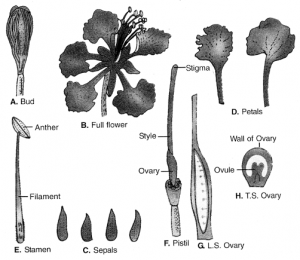
Flower of Gulmohr
Observe a floral bud (figure. A). In the next whorl, we find outer leafy structures of the bud are the sepals of the flower (figure C).
Next to the sepals are five brightly coloured petals (figure D). They are the most conspicuous part of the flower and make it attractive.
In next whorl, we find long filaments. Each filament is a part of a stamen (figure E). It has a distinct tip with two anthers.
Split open an anther. We find fine yellow particles in the anther. These are the pollen grains.
In the next whorl, we find a single elongated structure in the centre of the flower. It is broader below and tapers at the top. This is the pistil or carpel (figure F). The lower broader part is the ovary. Its slender elongated part is the style. The end of the style which is sticky is the stigma.
In longitudinal section of ovary, we find whitish structures (figure G). These are the ovules. The ovules are attached to the margin of the ovary (figure H).
Gulmohr has both male (stamens) and female (pistil) parts of the flower. It is, therefore, a bisexual flower.
Note:
All plants do not have flowers with both stamens and carpels. Some have only stamens and are the male flowers. Some have only pistil, and are the female flowers. Such flowers are called unisexual flowers.
Examples: Cucumber and gourd.
Conclusions:
A flower represents the reproductive part of a plant body. It is, the most important part meant for multiplication of the species.
Often, each flower has a stalk called the pedicel. But some flowers do lack the pedicel, and such flowers are called sessile. Besides the stalk, a flower, in general, shows four sets of whorls or parts arranged in rings or whorls (Figure).
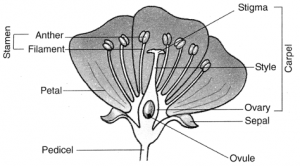
Parts of a Flower
1. Calyx is the outermost whorl or set composed of green, leaf-like protective structures called sepals.
2. Corolla is the next inner whorl composed of brightly coloured petals. Being brightly coloured, petals attract insects for pollination.
3. Stamens are next to corolla and consist of anthers and filaments. Anthers are swollen structures present on the tip of filaments. The anthers produce a powdery substance consisting of tiny structures called the pollen grains. The stamens represent the male part of a flower. Male sex cells are produced inside the pollen grains.
4. The central part of the flower is the female part, consisting of a flask-shaped organ, called the carpel. Each carpel consists of a basal swollen part called the ovary. The ovary continues into a long style and ends in a knob-like part, called the stigma. The ovary contains many ovules. Female sex cell is present inside the ovule. Ovules and ovary finally develop into seeds and fruits respectively.
| Largest flower – Rafflesia grows in Indonesia ; nearly 1 metre in dameter.
Smallest flower – Duckweed (Wolffia); only about 0.5 millimetre in diameter. |
Types of Flowers
Based on the presence of whorls, flowers can also be classified as follows:
Complete flower: A flower consisting of all the four whorls-calyx, corolla, stamens and carpels is called a complete flower.
Examples: mustard, china-rose and pea.
Incomplete flower: In some flowers, one or more whorls may be missing. Such flowers are called Incomplete flowers.
Examples: date palm and mulberry.
Functions of A Flower
1. Role in reproduction and multiplication:
The flower is the most important part of a plant i.e., it takes part in reproduction and leads to the formation of seeds and fruits. Seeds on germination produce new plants.
2. Ornamental value: Flowering plants are grown in gardens and in homes because of their bright colors and fragrance.
3. Source of food: Nectar from flowers serves as food for insects.
7. SEXUAL REPRODUCTION
In nature, sexual reproduction occurs in plants as well as in animals. It is the most common method of reproduction. A flower is the seat of sexual reproduction in plants.
Two parents, one male, and the other female are required for sexual reproduction. Two types of sex or reproductive cells, called gametes are produced from the reproductive organs of two parents. The male parent produces the male gametes and the female parent produces the female gametes.
The stamens produce pollen grains which contain the male gametes. The female gamete is a large egg-cell produced inside the ovule.
A male gamete is usually small with a nucleus and little cytoplasm. The female gamete is larger, with a nucleus and more cytoplasm than the male.
The fusion of the two gametes is called fertilization. The product of the fusion of the two gametes is called the zygote.
After fertilization, the zygote undergoes cell division and growth. Ultimately, it forms the new individual.
8. POLLINATION
Pollination is the transfer of pollen grains from the ripe anther to the stigma. The transfer of pollen grains to the stigma can take place in two ways:
(i) Within the same flower or between flowers of the same plant.
(OR)
(ii) Between flowers from different plants of the same species.
Pollination in the first case is called self-pollination, while it is called cross-pollination in the second case(Figure.).
Cross-pollination often involves various external agencies to carry pollen grains from one flower to another one. These agencies may be air, water, or insects. Most flowers are pollinated by insects.
Pollen grains of all flowers are not carried by insects. In some cases, they are carried by wind (wind pollination). In the case of water plants, pollen grains are carried by water (water pollination).
Self and Cross-pollination
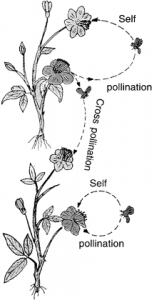
| DIFFERENCE BETWEEN INSECT-POLLINATED AND WIND-POLLINATED FLOWERS | |
| Insect-pollinated flowers | Wind-pollinated flowers |
| 1. Large and brightly-coloured
2. Nectar and scent is produced. 3. Pollen grains are sticky. 4. Pollen grains are produced in less quantity. |
1. Small and inconspicuous.
2. No nectar or scent is produced. 3. Pollen grains are dry. 4. Pollen grains are produced in large quantity. |
9. FERTILIZATION
Fertilization is a step between pollination and seed formation. The fusion of the male gamete with the female gamete is called fertilization.
During fertilization, the following events take place:
1. The pollen grains germinate on the stigma, and pollen tubes develop.
2. The pollen tubes move downwards into the style (Figure).
3. The pollen tubes are the carriers of male gametes.
Pollen grain develops into a pollen tube carrying male gametes

Female gamete (egg cell) inside the ovule

Process of fertilization
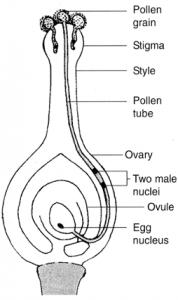
2. One pollen tube finally enters the ovule, where the female gamete (egg) is located (figure)
Female gamete or egg cell is present inside the ovule.
3. Finally the male gamete fuses with the female gamete. This completes the process of fertilization.
10. FORMATION OF FRUIT AND SEED
Formation of Fruit and Seed
1. The flower loses its bright color.
2. The sepals, petals, and stamens fall off.
3. The ovary increases in size and becomes the fruit.
4. The ovary wall becomes the fruit wall.
5. Inside the ovary, the ovules develop to form the seeds.
Types of Fruits
(i) Dry fruit: Fruits of the type of pea are called dry fruits. The fruit wall in such fruit is thin and dry.
Examples: Cotton, lady’s finger, maize, sunflower, bean.
(ii) Fleshy fruit: On the other hand, mango fruit is a fleshy fruit, as the fruit wall is thick and fleshy.
Examples: Tomato, brinjal, orange, coconut, plum.
Functions Of Fruits
(i) The fruit wall gives protection to the seeds and therefore to the embryo.
(ii) The fruit is a storehouse of food material.
(iii) The fruit helps in the dispersal of seeds.
Seed
A seed contains an embryo, one or two cotyledons, and a protective seed coat (Figure). The embryo, after germination of the seed, develops into a new plant. The cotyledons often contain reserve food material for the developing plant.
Structure of gram seed
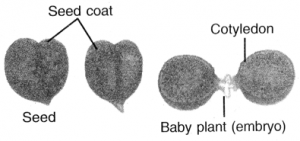
11. STRUCTURE OF A FRUIT
The fruit is a ripened ovary formed after fertilization. The fruit consists of two parts
(i) The fruit wall (or pericarp), and(ii)Seeds.
Fruit Wall
The fruit wall develops from the wall of the ovary. It may be thick or thin. It may be dry as in pea or gram (Figure) or fleshy as in tomato (Figure) and papaya. In fruits like mango, the pericarp may be differentiated into three layers (Figure):
The fruit wall has three layers:
1. The outer layer called the epicarp,
2. The middle layer called the mesocarp, and
3. The inner layer called the endocarp.
Parts of a Fruit (Tomato)

Parts of fruit (mango)
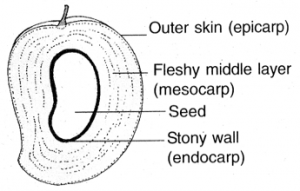
Seeds
Seeds that develop from the ovules are present inside the fruit wall. Fruit may contain only one seed (as in mango, plum) or many seeds, as in the case in tomato, orange, apple.
Fruits of the type of pea are called dry fruits. The fruit wall in such fruit is thin and dry.
On the other hand, mango fruit is a fleshy fruit, as the fruit wall is thick and fleshy
Functions of a Fruit
1. It protects the seeds from animals and unfavorable climatic conditions.
2. It helps in the dispersal of seeds to distant places by means of various devices which the fruits often develop.
12. THE SEED
A seed contains a baby plant inside. It also contains food for the new plant to develop. More precisely, the seed consists of an embryo, one or two cotyledons, and a protective seed coat. The embryo is represented by plumule and radicle (Figure). The cotyledons often contain the reserve food material for the developing plant. On germination, plumule gives rise to the shoot system while radicle gives rise to the root system (Figure) and thus, develops a new plant.
Parts of a seed – The two cotyledons slightly separated showing the embryo plant between them
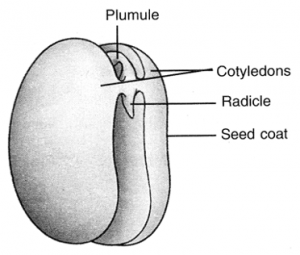
Seed Germination
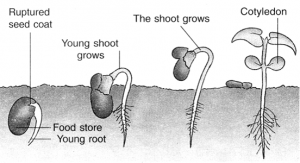
13. DISPERSAL OF SEEDS AND FRUITS
The plant does not move. The seeds and fruits produced by them have developed devices that help them to be carried to faraway places. This prevents overcrowding at one place and also leads to the spread of plants to newer places. There are three main types of dispersal mechanism:
(i) By Wind (ii) By Water (iii) By Animals
Dispersal by Wind
Examine the seeds of a dandelion, Calotropis (Madar), Acer (maple), cotton, and pine.
Seeds of dandelion (Figure.) and cotton possess a tuft of fine hair, while in Acer and pine (Figure), the fruits/seeds develop flat, wing-like structures.
Dandelion

Winged fruit of Acer
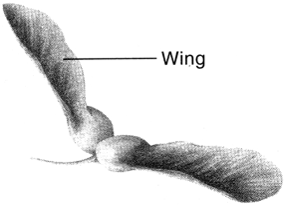
The hair or the wings help in the dispersal of seeds and fruits too long distances by wind.
Dispersal By Water
Coconut plants are grown on the seashore. The fibrous fruit falls in the water and is carried away from the parent plant by water currents.
In the lotus, the fruit floats on the surface of the water and the seeds are liberated in water. Water currents carry the seeds too long distances.
Dispersal By Animals
Seeds and fruits dispersed by animals are either edible or develop hooks and thorns. Seeds of fruits like mango, orange and plum get dispersed after the fleshy part of these fruits is eaten by humans and birds.

Fruit of Xanthium with spines
Fruits of gokhru (Tribulus) and okra (Xanthium) possess hooks and spines (Figure). These fruits stick to our clothes and to the body of passing animals and then get carried away from one place to another.
This, plants have developed various means to get their seeds and fruits carried away too long distances.








